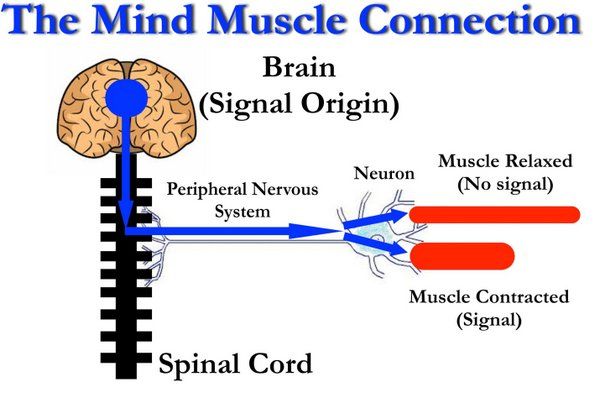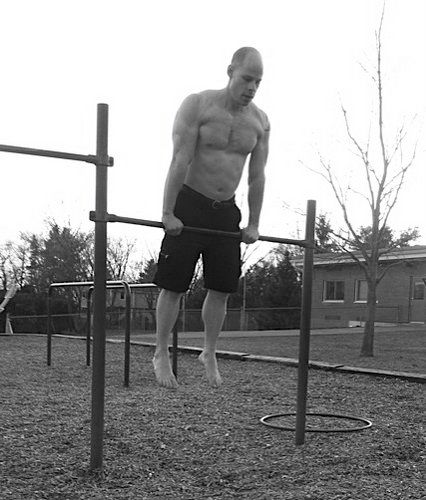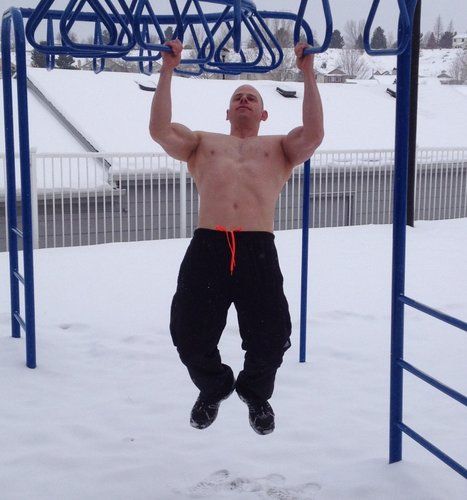
“You must be crazy! How can I possibly have weak glutes and hamstrings?!”
I’m at the chiropractor and I’m finally throwing in the towel on my lower back pain. I’m not a model patient.
“Do you know how much I deadlift and use kettlebells? Those things are like glute and hamstring blasters.” Then he told me something that changed everything about how I used exercise for the next 10 years; “Matt, exercises don’t work your muscles, only your brain can do that.”
I thought he was nuts but then he hit me with the science of what he was talking about.
“It’s simple; the signal instructing certain muscles to contract and how they work doesn’t come from a weight or a special exercise. Your brain creates a signal, it travels through the nervous system and eventually reaches the muscle fibers as your mind instructed. Everything about how the muscle behaves comes from your brain.”

It was a simple lesson, but over the years it has completely enveloped my entire approach to all aspects of my training. From calisthenics to bike racing and even walking has taken on new meaning due to this mind-muscle connection.
Here are some of the biggest lessons I’ve learned in how the mind-muscle connection has changed my calisthenics training:
#1- Distraction dilutes the mind-muscle signal
Anything that pulls your thoughts away from the exercise literally dilutes the signal you’re sending to your muscles. TV, talking, smart phones, even some types of music are now training enemy #1.

#2- Mind-muscle signals become habitual
Habit is simply repeating the same mental signals over time. This repetition causes those signals to become easier to create and more powerful in their application. Of course habit can be both a great benefit and a massive detriment to your training. If your usual signal is to use your lats while doing pull ups you’ll use them in other activities as well. However, if you’re not in the habit of using them, they won’t turn on no matter how many pull ups you do.
#3- The signal can change at various points during the range of motion
It’s not uncommon for a signal and thus a muscle contraction to change during an exercise. At some points during the range of motion, it may be stronger and other points it may be weaker. Some common examples can include triceps relaxing at the bottom of a push up but contracting very powerfully at the top and glutes to shut off at the bottom of a squat while they may kick in halfway up towards standing.
Working to maintain the signal throughout the full range of motion makes a huge difference in the strength of the muscle as well as the integrity of the joints.
#4- It takes practice to get the muscle to do just what you want it to do
It’s common to not really feel a muscle turning on the first few times you try to use it more during an exercise. Sometimes it takes some time for the signal to develop and beat a neurological path to the muscle. I found this to be the case with my abdominals during the leg raise progressions. At first it felt like my abs were hardly doing anything, but the more I focused on turning them on, the more they eventually got into the game. Now hanging leg raises result in a deep abdominal burn and more powerful contractions even though the actual workout hasn’t changed much. Don’t be discouraged if nothing feels different at first. Keep concentrating and things will change very soon.
#5- Small and stubborn muscles may be due to a weak mind-muscle connection
My shoulders have always been a weakness for me. It didn’t matter how many shoulder exercises I did, they just wouldn’t grow and really develop. Once I started working on the mind muscle connection with my shoulders I was surprised to find how weak the signal was. Once the signal became stronger my shoulders grew like crazy. This was also the case with my hamstrings as I mentioned before.

#6- Exercises, and tools are simply templates for developing the mind-muscle signal
One of the biggest lessons about the mind-muscle connection was that there’s nothing in there about supplements, gadgets or fitness dogma. The root cause of all things muscle comes from the brain, not a product you can buy in a store.
As for a particular exercise, each movement places a certain demand upon a set group of muscles, but it’s a rough template for where the tension needs to go and how hard the various muscle contract. It’s up to your own focus and skillful concentration to refine the tension and direct it to the target muscles.
The million dollar question is: how can you develop and refine the mind muscle connection?
There are many techniques, but the common element is simply trying to build and control the tension in a select number of muscles through your own focus and concentration.
When I’m trying to really dial in my mind muscle connection I use what I call the P.T.R (Peter) method. Here’s how it would work with a classic push up.
Step 1- Set your Position
The first thing is to take your time setting up your position for the exercise you wish to do. This should be a pretty relaxed thing to do. In the case of push ups, I like to start my push ups laying on the floor so all of the muscles are relaxed. I then take my time placing all of my limbs and joints in the most perfect position I can. I check the position of my hands, elbows, shoulders, spine, hips, neck, even the placement of my fingers is something I really focus on getting just right.
Step 2- Set your Tension
Once I’m in position, I fire off the mind-muscle signal by tensing the muscles I want to involve during the exercise. I’m still laying on the floor, all of the tension is entirely proactive. I’m just flexing the muscles I want to engage as hard as possible. This can include my chest, shoulders, hands, lats, abs, triceps, quads and forearms. Lately I’ve been focused on getting my triceps more involved with my push ups, so I’ve been focusing more on tensing up the triceps.
Step 3- Apply Resistance
Once the tension is set just the way I like then I slightly lift myself off the floor and begin my set. Once the resistance is applied, the tension in the muscle grows much more, only now it’s flowing along the channels already established in step 2. So if I’m working to get my triceps more involved they now carry more of the resistance of the exercise.
The P.T.R method conditions you to really dial in the tension of any exercise you choose. It builds your ability to direct and alter the tension in your muscles at will so you can modify that tension however you wish.

Contrast this with simply dropping down and firing off push ups as fast as possible. The position and tension your body uses is going to be much more reactive rather than proactive. If you’re used to using your shoulders more than your triceps during the push up then that same pattern of signal will be generated. It’s not a bad thing, it’s just that it’s much more difficult to focus and change the mind-muscle connection and thus how your mind is asking your muscles to perform. Your old movement habits will take over both good and bad.
In closing I want to leave you with a couple of mantras I’ve used with my clients to reinforce the awareness of the mind-muscle connection:
– Muscle follows mind.
– Exercise doesn’t work muscle; your focus and concentration works the muscle.
– Nothing different happens in your training until you chose to make it different.
– Exercise technique is more than just keeping your back straight or toes pointing forward. Technique is about refining the mind-muscle signal. Thus technique isn’t everything, it’s the only thing.
– Effecting training isn’t just about blood sweat and tears. It’s about learning how to engage and use your body in a more effective way.
Yours in strength,
-Matt Schifflerle
****
Matt Schifferle a.k.a. The Fit Rebel made a switch to calisthenics training 5 years ago in an effort to rehab his weight lifting injuries. Since then he’s been on a personal quest to discover and teach the immense benefits of advanced body weight training. You can find some of his unique bodyweight training methods at www.RedDeltaProject.com.
